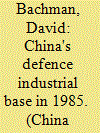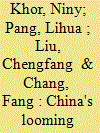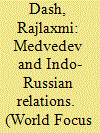| Srl | Item |
| 1 |
ID:
121212


|
|
|
|
|
| Publication |
2013.
|
| Summary/Abstract |
This essay assesses various dimensions of China's defence industrial enterprises. It argues that the defence industrial system should be divided into two tiers: tier one, composed of weapons and equipment producers for the military, and tier two, composed of "civilian" industrial enterprises that provided critical inputs for tier one enterprises, and which in national emergencies could be mobilized to produce weapons themselves. In 1985, there were 1,158 tier one defence enterprises and 827 tier two enterprises among China's 8,285 large- and medium-scale enterprises. Additional information is provided on defence enterprise shares of the economy at the provincial and the national levels, on enterprise distribution by industrial sector, and on when enterprises were built. The article attempts to estimate the total number of workers, output value and fixed assets of the defence industrial sector, and their weight in the national economy.
|
|
|
|
|
|
|
|
|
|
|
|
|
|
|
|
| 2 |
ID:
149742


|
|
|
|
|
| Summary/Abstract |
Accumulation of human capital is indispensable to spur economic growth. If students fail to acquire needed skills, not only will they have a hard time finding high-wage employment in the future but the development of the economies in which they work may also stagnate owing to a shortage of human capital. The overall goal of this study is to try to understand if China is ready in terms of the education of its labour force to progress from middle-income to high-income country status. To achieve this goal, we seek to understand the share of the labour force that has attained at least some upper secondary schooling (upper secondary attainment) and to benchmark these educational attainment rates against the rates of the labour forces in other countries (e.g. high-income/OECD countries; a subset of G20 middle-income/BRICS countries). Using the sixth population census data, we are able to show that China's human capital is shockingly poor. In 2010, only 24 per cent of China's entire labour force (individuals aged 25–64) had ever attended upper secondary school. This rate is less than one-third of the average upper secondary attainment rate in OECD countries. China's overall upper secondary attainment rate and the attainment rate of its youngest workers (aged 25–34) is also the lowest of all the BRICS countries (with the exception of India for which data were not available). Our analysis also demonstrates that the statistics on upper secondary education reported by the Ministry of Education (MoE) are overestimated. In the paper, we document when MoE and census-based statistics diverge, and raise three possible policy-based reasons why officials may have begun to have an incentive to misreport in the mid-2000s.
|
|
|
|
|
|
|
|
|
|
|
|
|
|
|
|
| 3 |
ID:
109731


|
|
|
| 4 |
ID:
082559


|
|
|
|
|
| Publication |
2008.
|
| Summary/Abstract |
This article examines the employment and occupational status of South Asian female migrants in Australia, mostly Indian and Sri Lankan. It highlights their work differentials with both native-born and other female migrants in this multicultural context and confirms that they are a highly selected population who potentially bring considerable economic benefits to the receiving society. The observation that South Asian female migrants in Australia are able to contribute significant human capital in the form of language and education skills, but do so to some extent on their own terms, suggests that more careful attention needs to be paid to selecting migrants from South Asia and facilitating their entry into the labour market
|
|
|
|
|
|
|
|
|
|
|
|
|
|
|
|
| 5 |
ID:
190823


|
|
|
|
|
| Summary/Abstract |
This paper analyses irregular Afghan migrants in Turkey based on a qualitative field research study conducted in the cities of Ankara, Bursa, Malatya, Kayseri and Istanbul (see Note 1 on use of the term ‘Afghan’). It focuses on their migration journey, the factors driving migration and post-migration challenges. This research seeks to answer why Afghan irregular migrants are mainly male adults and how the employers in Turkey treat them. Afghan migrants in Turkey are mainly unskilled members of the labour force, typically working in construction, in supermarkets, as shepherds and in kitchens. This study argues that Afghan migration motives are mainly driven by humanitarian and economic deprivation. However, when they arrive in Turkey, migrants have no legal protection and are thrown into despair by their employers’ mistreatment.
|
|
|
|
|
|
|
|
|
|
|
|
|
|
|
|